This week I feel as though there is a lot to reflect on, so I’m going to break it down into subheadings. Terms like ‘unique’, ‘complicated’ and ‘simple’ you’ll find will probably be in quotation marks as I feel like these terms will form part of my research into camera coverage and their definitions to me will most likely change over time.
FOUND SCENE:
The task of finding a scene and analysing the camera coverage sounded interesting and exciting, until I had to choose an actual scene. The issue I found wasn’t discussing the camera coverage and possible reasons the filmmakers chose to use certain shots, but rather finding a scene that was ‘unique’ in the way it had been covered. I didn’t think it would be difficult at all to find a scene from some of my favourite films, as one of the main reasons why I loved these films is due to their scene constructions, right? As it turns out I was wrong.
As I began to pull apart some of my favourite films, isolate and analyse particular scenes that had impacted me, I began to realise that there were reasons other than the camera coverage that helped me connect with the film. When I isolated particular scenes and watched them repeatedly to find some kind of meaning behind the camera coverage, I found that even listening to the dialogue out of context at times made the dialogue sound contrived. This was quite frustrating as I began to feel as though my judgement of these films as being amazing was not as well considered as I originally thought. Perhaps these films stood out to me for the way in which the film as a whole worked together (with the script, cinematography, and performances working together) and the scenes themselves were just building blocks towards the climax with nothing ‘unique’ about the camera coverage.
This prompted many questions as I became quite frustrated in trying to find a scene based on camera coverage that I could analyse and describe the possible meaning and reasons behind the chosen set-ups. How is it that these films that had stood out of the pack and I had encouraged my friends to watch have ‘simple’ scene constructions and camera coverage? Did the director purposefully use ‘simple’ camera set-ups in order to allow the actors performances to shine through? Did the tone and slow-burning rhythm of the films mean that using more complicated camera coverage would distract the viewer from the action? Or were the reasons purely to do with the place and time the films were made (eg; Hollywood)?
What I found to be an interesting scene to analyse came from an unlikely film in The Way Way Back. While I did really enjoy watching this film, the cinematography and camera coverage didn’t originally stand out to me. It was only until I decided to pick apart the scenes that I began to gain more appreciation for it’s camera coverage.
Questions like these will continue to form my research throughout the semester and challenge the way I think about camera coverage and scene construction.
WEDNESDAY EXERCISE:
I found Wednesday’s exercise to be much more challenging than last week’s exercise, not just because of the constraints of the task (editing in camera, 3-5 shots) but because my group again had (I never thought I would say this) a script to work off. A couple of people who had been in my group last week agreed that having a script seemed to be more of a creative limitation than just having a scene description. We found ourselves spending more time scrutinizing the script and feeling forced to follow the script to a tee. Every creative shot we came up with was then changed to accommodate the script’s specific actions. We also had to decide where our minimum 3 shots and maximum 5 shots would be placed according to the script which also restricted our creativeness as we resigned ourselves to showing, for example, Antonio walking towards Susan and Linda as the script told us to, rather than changing the action to suit our creative vision.
Having come from the Screenwriting course, I have always been able to visualize how I would expect my scripts to be adapted to the screen. I had been trained to write in a way that was instructive to the director, yet leaving room for a director’s creative visual choices. So finding this task as being restrictive because of the script was quite bizarre for me, however I found myself saying “I wish we didn’t have a script.”
Seeing the way in which the other two groups were able to create visually interesting, beautiful, and even hilarious scenes by their camera coverage choices compared to ours made it clear that the material you have to work from as well as the individual’s vision can create such starkly different scenes. I was really blown away by some of the shots that they had created and even felt a ping of jealousy that they were able to interpret their given scene in a purely creative way with less restrictions.
FRIDAY EXERCISE:
So I got another script to work with for Friday’s exercise. Being a bit disappointed that I couldn’t experiment with a different form of instructive text, I tried to really think of creative ways to show the action without feeling restricted by the specifics in the script. While a couple of people went and scouted for a location, the rest of us discussed some really interesting ideas, however when we arrived on the location it became apparent that we couldn’t film all of the shots exactly how we wanted. One of the issues we came across in the script was that the character in one action goes from having her head out of a window to looking into a mirror on a wall. In our discussion we thought it would be interesting to use the camera as a mirror and have the actor look directly into it.
We still came up with a few dynamically interesting shots and were really excited to shoot them especially because we had such a cool backdrop of the city (our location was a balcony). Because the location that was chosen by our two location scouts was exterior and there was no mirror to use, we improvised by using the camera on a mobile phone as the mirror. While at the time it seemed like a great solution, I feel as though if we had found an interior location with a mirror, we would’ve had more opportunity to play around with the reflections and create something quite unique. Other concerns about the location were the cramped nature of the balcony and the noise from nearby construction.
After discussing the shots in the location and cutting the script into the maximum 6 shots we were allowed, we began shooting. We shot out of order so that we wouldn’t have to continually move the camera’s position. After each shot, we rotated roles so that most people could have a go at filming a shot. While we all agreed this was a great idea, the cramped quarters of our location made it difficult to oversee what other people’s shots looked like. While at the time we thought the shots looked great, it wasn’t until we actually got to see the shots properly in post that it became clear that they weren’t executed as well as we thought (eg; focus, exposure, camera balance, height of tripod – not showing the backdrop that well).
Having to stick to the industrial model and log our takes also became quite tedious. This process might be helpful for a bigger shoot with more shots (eg; a short film) but for one scene it seemed pointless. When I began reviewing and assembling the shots in post, I followed the log sheet, however I found that with a bit of tweaking to overcome the continuity issues recorded in the log sheet, I could use the lower rated shots and actually sometimes preferred using them. While we had more ‘freedom’ with this exercise, it became clear that perhaps having more constraints meant that we had to think more outside of the box and more creatively in previous exercises rather than this one.
While it was a collaborative effort and everybody had a small contribution, I feel as though maybe we didn’t all get a say in how the scene was shot and that there were great creative opportunities that were missed. Not letting everyone’s voices be heard meant that their great ideas were also missed out on, which is a real shame. While we are each supposed to be experimenting and creating an understanding about our own methodology, I don’t feel like everyone is being able to speak up and grow individually as a filmmaker. I think this really does depend on the dynamics of the group and personalities, which can make people feel like taking a back seat rather than contributing their thoughts. While we don’t have enough cameras or time to allow every student to film their own scene, I think there may be other ways to try and overcome this issue. I think a way to overcome this might be to in the next filming exercise, rather than discuss the shots as a group, have each person mark up the scene with how they would film it. Then go around the table and discuss what each person came up with, and have a constraint be that each person must have at least one of their shots filmed and filmed by them. Maybe this is a good idea, maybe it would make the scene look fractured, I’m not sure, but at least everyone would be able to present their ideas and learn from them.
Film: The Way Way Back (2013)
Quick Film Summary: Shy 14 year-old Duncan goes on a summer holiday with his mum, his mum’s boyfriend Trent and Trent’s daughter Steph. The friends he makes at his new job at the water park helps him gain his self-confidence.
Chosen Scene: Opening scene.
Shot List:
- Extreme C/U of Trent’s (Duncan’s future step-Dad) eyes in rear-view mirror.
- Medium C/U of Duncan sitting in the very back of the car, his back facing Trent.
- Extreme C/U of Trent’s eyes in rear-view mirror.
- Medium C/U of Duncan sitting in the very back of the car, his back facing Trent.
- Extreme C/U of Trent’s eyes in rear-view mirror.
- Medium C/U of Duncan sitting in the very back of the car, his back facing Trent.
- Extreme C/U of Trent’s eyes in rear-view mirror.
- Medium C/U of Duncan sitting in the very back of the car, his back facing Trent.
- Medium C/U of Duncan turning around to face Trent.
- Medium C/U (from Duncan’s P.O.V) of the back of Pam (Duncan’s mum) asleep in the passenger seat.
- Medium C/U of Steph (Duncan’s future step-sister) asleep.
- Medium C/U of Duncan facing Trent.
- Extreme C/U of Trent’s eyes in rear-view mirror.
- Closer Medium C/U of Duncan facing Trent.
- Extreme C/U of Trent’s eyes in rear-view mirror.
- Closer Medium C/U of Duncan facing Trent.
- Extreme C/U of Trent’s eyes in rear-view mirror.
- Closer Medium C/U of Duncan facing Trent.
- C/U of Trent’s eyes in rear-view mirror.
- Closer Medium C/U of Duncan facing Trent.
- Further Medium C/U of the back of Duncan, now facing Trent.
- C/U of Trent’s eyes in rear-view mirror.
- Closer Medium C/U of Duncan facing Trent.
- Medium C/U of Duncan sitting in the very back of the car, his back facing Trent.
No. of Camera Set-ups: 8
Analysis:
The film The Way Way Back opens with an awkward conversation between Duncan and his mum’s boyfriend Trent in the car on the way to their summer holiday house. The camera coverage chosen to film this scene establishes the distant and troubled relationship between Duncan and Trent as well as highlighting Duncan’s personality and view of the world.
The scene opens with an extreme close-up (no. 1) of Trent’s eyes in the rear-view mirror as he tries to engage in a conversation with Duncan. Choosing to frame his eyes so closely and never actually showing his whole face establishes him as an imposing and authoritative figure. As he continues to belittle Duncan, his eyes scrutinize him. The choice to not show Trent’s entire face makes the audience focus on what he is saying to Duncan, making Trent appear arrogant and cruel, and makes the audience empathize with Duncan. While it is clear that Trent is an important character in the film, the choice to only frame his eyes. and later the back of his head compared with the varying shots used for Duncan, helps the audience understand that Duncan is the protagonist. This repeated extreme close-up also gives the impression that Trent is looking down on Duncan as he isn’t framed turning his head to look directly at Duncan, which furthers the audience’s feeling of dislike towards him.
The following medium close-up (no. 2) of Duncan sitting at the very back of the car (in foreground) with his back facing Trent who is small in the frame (in background) establishes the distance in their relationship and their inability to relate to one another. Positioning Duncan right at the back of the car with the luggage in frame demonstrates to the audience that he is not regarded as important by his family as well as the world. The choice to show Duncan’s whole face throughout the scene allows the audience to see his reaction to Trent’s belittling and puts them on Duncan’s side. These two shots continue to be edited side-by-side until Duncan becomes increasingly upset with Trent’s comments and turns around to face him in medium close-up (no. 9).
When Duncan turns around, his point of view is shown in the form of a medium close-up of his mum sleeping in the passenger seat (no. 10). This demonstrates that nobody else in the car is aware of what Trent is saying to Duncan and therefore won’t stand up for him – Duncan has to fend for himself. His mum being positioned in the passenger seat next to Trent also suggests that she is on Trent’s side and not Duncan’s. The medium close-up of Steph lying across the whole back seat of the car, asleep (no. 11), further demonstrates that Duncan isn’t treated equally in the family as he could have easily sat in the seat beside her rather than at the very back with the luggage.
The conversation between Trent and Duncan continues with the editing of an extreme close-up of Trent’s eyes in the rear-view mirror and a closer medium shot (no. 14) of Duncan facing Trent. This demonstrates that Duncan wants to defend himself but doesn’t have the self-confidence to do so. Framing Duncan in a tighter frame puts more pressure on him and gives the audience the expectation that he will defend himself against Trent’s comments. The extreme close-up of Trent’s eyes in the rear-view mirror becomes a close-up (no. 19) when he begins talking about them all becoming a family to soften the audience’s view of him slightly while also establishing more distance between him and Duncan. The following medium close-up from the back of the car with Duncan’s back in the foreground (no. 21) further demonstrates the irony of Trent describing the four of them as a family as there is a lot of distance between all of the characters. It becomes clear to the audience that Duncan has given up when he turns around with his back to Trent in the same medium close-up he was first shown in (no. 24) as he decides to just listen to his music instead of having a conversation with Trent. The camera set-up is the same as the first shot we saw Duncan in, giving the audience the impression that Duncan’s conversation with Trent hasn’t changed anything, and Duncan won’t take any of Trent’s advice.
The main reason why I found this scene interesting is because there is no establishing shot of the car or road, rather the opening shot of the entire film is an extreme close-up of a secondary character in the film. This results in a quite jarring feeling for the audience, but as it is so close it draws you straight into the action and forces you to listen intently to the dialogue as you can’t see Trent’s mouth (at all in the entire scene).
The choice of camera shots and framing allows the directors to give the audience the information slowly rather than all at once (for example; if they had opened with a wide shot of all of the characters in the car the audience would understand the family dynamics straight away). The camera in the beginning of the scene only frames Trent and Duncan separately, and quite closely giving the audience the impression that Trent is Duncan’s dad.
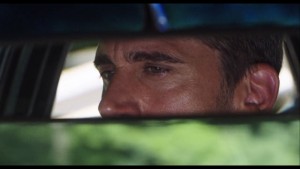
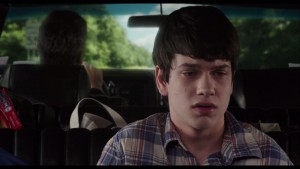
The camera ‘world’ opens up as Duncan’s point of view shows his mum and Trent’s daughter Steph; introducing the audience to new characters while Trent’s dialogue explains that he isn’t Duncan’s real dad.Towards the end of the scene, the camera is positioned slightly further away to represent the distance between all of the characters and making it clear that this ‘family’ will not be able to become a close unit.
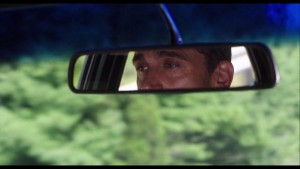
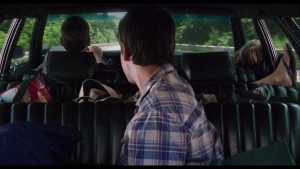
The camera coverage chosen in this scene not only establishes who the protagonist is but also gives the audience an insight into how the world perceives him and how he perceives the world without him having much dialogue at all. The shots establish that he is insignificant within his make-believe family, he has low self-esteem, and his step-father is driving a wedge between him and his mother, which inform the rest of the film. The camera coverage and shot selections reveal more about the characters and their relationships with one another than the dialogue even does.
Last year in TV-1 and TV-2 I learned and gained experience in a wide range of technical and production skills. I thoroughly enjoyed being able to create a short film and documentary, both of which were fantastic learning experiences. While we were able to try our hand at different production roles and construct our shots based on our script/documentary outline, variables such as time and the weather tended to alter our idea of how we would film a particular shot or scene.
This course excites me because we have the opportunity to really focus and practice our skills by working on one scene, rather than a complete film. Robin and Paul’s comments in the lecture really resonated with me as having the pressure of submitting a complete film to a deadline did mean that on our shooting days we had to cut certain shots for our coverage of our scene in order to finish filming.
Being able to think about scene construction and the many different ways a scene can be ‘covered’ is really interesting as there aren’t really any rules (as was pointed out in the lecture with the discussion about crossing the line). How creative, innovative, simple or complicated you want the camera coverage to be is completely up to the individual. Thinking and experimenting with camera coverage means that hopefully we will all as individual filmmakers be able to find our own ‘style’ or even possibly ‘authorship’ that we can continue to develop throughout our careers.
Another point that was raised in the lecture that intrigued me was the idea of researching the way different filmmakers and even films from different countries construct their scenes and exploring why this occurs as well as the effectiveness of their individual styles.
The constraints that were set for the first task forced us to think differently about a scene. Rather than relying on a shot-reverse-shot for a typical conversation between two characters, my group had to experiment and work out the most interesting way we could present our scene. After switching roles a few times and testing out different but yet still quite common shots (shots we have seen time and time again), we discussed what we thought the subtext of the scene we were assigned was. We decided that the characters had had a past relationship and the female was concerned about revealing her engagement to the male (also her boss). The majority of the action also comes from her, (walking into the office, talking to her boss, turning to leave but then stopping, etc) so we tried framing her action while keeping the boss’ identity a mystery and placing the camera behind him. This resulted in a construction of the scene that we were all very excited about as the choices we made were not something we had commonly seen. This exercise proved to us that focusing our energy on how to portray the relationship between the two characters and experimenting with abstract shots can create something quite unique and interesting.
Overall, I thought that the quality of the films were of a high standard this semester and I found the screening to be really enjoyable due to the diverse nature of the films.
Black Cat
The unique visual style and experimentation with sound overlay really drew me into this film. This is a subject that I wasn’t necessarily interested in but became engaged with due to the interesting approach you took and the balance of bizarre with a bit of comedy.
Theanna
This documentary was the most emotional to watch for me. In the beginning I thought that the subject might not be that engaging, however, the clever editing to build up the suspense of her opening the letter for the first time really drew me in. It is truly a beautiful documentary and the subject was very interesting. I think a lot of people would be able to relate to this story and connect with it which is a credit to you.
Cactus
The subject was really interesting and I really enjoyed his enthusiasm for his passion, even though it may be obscure. I felt like I wanted more and I didn’t want the documentary to end, he is such an interesting character and seeing him in different settings or more vision of him interacting with his friends at the society could’ve been added.
Waves
The sound design really complimented the interesting cinematography of this documentary. The exploration of one surfer’s passion through only narration also made it stand out and I think was a great choice as any on-screen dialogue would’ve broken the spell of the documentary. It really drew me into the feeling of being in a different world and was quite hypnotic. My only suggestion would be that the ending of the film could’ve been shortened.
Sneakerhead Collective
This is an excellent documentary, I really enjoyed the way it was structured in a clear, concise narrative. All of the subjects were really interesting, and I think you really succeeded in exploring a unique topic that not many people would’ve known about beforehand. All of the visuals were fantastic and not jarring at all, the entire film flowed incredibly well. I feel as though you could create your own online documentary series with the same structure and receive a great following – really high standard work.
Forbidden Xanadu
I know a few people have commented that they prefer the opening half of the film focusing on the Melbourne street art compared to the train graffiti in the second half, however I disagree. Yes, the visuals and editing were fantastic in showing off Melbourne’s street art scene, however I became more drawn into this film when it became something different to what I was expecting – the train graffiti. The pacing of each part of the film suited the different styles of graffiti you were demonstrating, and the different culture. I would suggest interviewing people who graffiti trains to make this part of the film more interesting to others and to provide a nice comparison and contrast to the street artists apparent in the first half. I came away from this film wondering what the motivation of the people vandalizing trains is and even though I have my assumptions of what they are, I think this would’ve been the perfect opportunity to hear their point of view. So, overall, I think that the change in pace in this film was refreshing and exploring people who participate in the train graffiti would’ve added more depth to the film.
Fans and Followers
This was a documentary that I saw in the class screenings, and the work apparent in the follow-up editing really improved the film. I thought it was quite an interesting approach and topic, but perhaps a clearer and consistent style of filming and sound design would’ve made it a more cohesive film.
Althea
This was absolutely brilliant. I want to watch this documentary over and over again. The subjects you interviewed were all very interesting and the editing of the fighting made it theatrical and hilarious. Loved every bit of it. Especially when they then discussed what they were planning to eat afterwards. Excellent film.
Question 1: Colour Correction Examples
Using the method of duplicating the same clip three times and testing different colour correction techniques has been very helpful in correcting overexposure and washed out colours in our documentary Bluestone. By using a combination of the three-way colour corrector, and the brightness & contrast functions, we have been able to create more vivid looking clips. Below are a couple of examples:
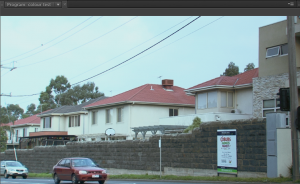
This is a screenshot of the original clip showing the outside of Pentridge Village facing Murray Road where the bluestone wall has been significantly lowered to show the housing estate behind. The clip is overexposed and washed out, the colours aren’t vivid at all.
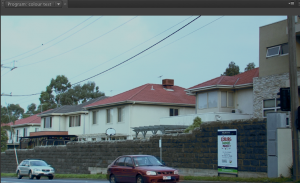
This screenshot shows the result of bringing the brightness down and bringing the contrast up, which made a slight difference in the washed out tone of the clip. However the contrast on the wall towards the right has given it a fake blue tone that doesn’t look natural.
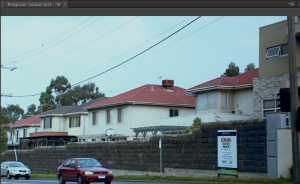
This colour correction experiment shows the contrast has been brought up more significantly and yellow has been added to the highlights to make the sky look less of a fake blue tone (as our white balancing for this shot was not right) and to make it look more realistic. However, the significant contrast on the wall to the right of frame looks more fake than previous attempts and doesn’t blend with the rest of the image so we are more likely to go with the previous attempt.
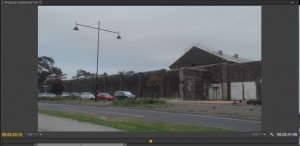
This is a screenshot of the original clip that is a bit overexposed and washed out. Our goal would be to make the sky have more definition and have the colours pop more.
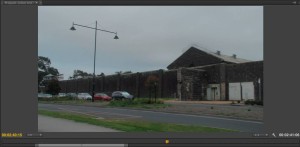
This screenshot shows that we have decreased the brightness which has made the sky less white and overexposed, as well as increased the contrast of the clip to make the dark tones in the wall and grass more visible. While this is an improvement, an experiment with the three-way colour corrector wheel could make the colours stand out more.
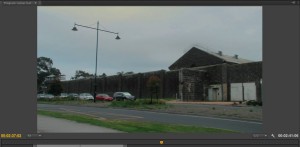
This screenshot shows our use of the brightness and contrast functions (as before) as well as the three-way colour corrector wheel. The increase of yellow in the highlights make it appear as though the sun is somewhere behind the clouds and breaks through the overall blue and grey tone of the rest of the clip. This is the version we would use in our final cut.
Question 2: Review your response from the beginning of the semester of your expectations. Has it delivered what you expected?
“This semester I would like to continue to learn and practice the technical side of production by engaging more with the equipment and not being afraid to try new camera and sound kits. I would also like to be creative and lateral in the way I approach my documentary project, so rather than implementing traditional interview techniques, I want to think outside the box. I want to use complex and interesting soundscapes and music which often add a depth to documentary films and to think more about how sound can contribute to the audience’s feelings and perceptions. Being creative with the camera will also be something I strive to do this semester by thinking about the many different ways a particular shot can be covered. I also want to gain more confidence in using the camera as I was a bit reluctant to get involved last semester as others were more confident to use it. I also want to not only improve my editing skills but have a more positive attitude towards it, rather than getting overwhelmed by the problems that may occur. Overall, I would like to be involved in a project that interests me whole-heartedly and to develop a documentary in which passion and creativity is demonstrated.”
Working on our documentary this semester has been an absolute joy, even through all of the trials and the tribulations we have developed a documentary that we are all proud of. I was extremely lucky to have been in such a hard-working, passionate, and funny group which made the whole process so much easier and enjoyable. My goal was to have more self-confidence in taking the reins of the technical side rather than letting others step forward and I can say I definitely did that this semester during our many shoots. While I still struggle with the sound recording (I need to practice this more), my confidence in using the EX3 and Z7 cameras grew the more I pushed myself to have a go. While we weren’t as creative as I expected to be in the beginning of semester, I feel that we utilised many different techniques to create a rounded documentary. The soundscape is something I regrettably didn’t follow through with. It is a really integral part to a fantastic documentary and we really struggled in this department in trying to find the right music and tones. The benefit of having a library collection of free music now really does seem important to me (a bit too late!). I believe that I developed more editing confidence and a better attitude towards the process the more I attempted it. However, while I enjoy putting a rough cut together and colour correcting, the minute editing details of dropping out audio and fading it in, etc, still does my head in, which is why I was lucky to have people like Mia, Miguel and Monika to help in that department. I really enjoyed this semester more than last semester, and I believe that not only does it have to do with my fantastic group, but also the freedom we had to go out and explore whatever topic suited us, go out and film, see what we had and assess it and continue the process. Compared to last semester where there was a lot of pre-production planning, I found that going out and filming a dozen times was actually so beneficial for us and made it more enjoyable as I felt that we were actually achieving something rather than waiting around for the shooting date. This semester completely changed my mind about working on documentaries as I was never interested in this area of filmmaking beforehand and now I just want to make another one as I found it so rewarding.
1. In this clip from Forbidden Lies, Anna Broinowski’s 2007 film: describe in detail all of the audio, how it may have been recorded/sourced and how you think it has been edited / layered in post. (You do not need to describe how the music was recorded).
The audio in this clip of ‘Forbidden Lies’ is used to trigger certain emotions in the audience and demonstrate a shift in the tone of the documentary. In the beginning of the clip during the reenactment of scenes from the book, the music, sound effects and voice-over narration generate a romantic and fantasy-like sentiment in the audience. The sentiment suddenly changes when … voice is heard stating that the book’s account is a lie. The music, sound effects and voices of the participants then become quite fast-paced and shatter the fantasy of the romantic reenactment.
During the beginning of the clip, Norma’s calm voice-over reading from the book tells the story of the romantic fantasy-like reenactment seen on screen. The soft romantic singing of lyrics detailing the romance is layered awell as calming acoustic guitar music. Sound effects such as harps, chimes, chirping birds are also layered to add to the romantic and fantasy-like theme of the scene. The man’s shining smile is accompanied with a cheesy ‘cling’ sound effect, the sound of the car is also layered as well as the rushing wind sound effect as the woman dramatically releases her veil and symbolically her ties with her past Muslim identity. The ‘thump’ sound of the veil falling to the ground is also intentionally dramatic to represent this.
Suddenly, the sound effect of a mouse click and a book ‘thump’ interrupts the fantasy. The voice-over detailing that these ‘facts’ are untrue signifies a shift in the tone of clip and the sound accordingly. The sound effect of the sand falling is used to signify the disintegration of the ‘truth’. When the book ‘Forbidden Love’ is shown the ‘cha-ching’ sound effect is heard to give the audience the impression that the book has been fabricated by Norma for monetary purposes. When the authentic Jordanian women talk about the lies in the book, there is a calming and soft arabic singing is heard which is the complete opposite to the Americanised music in the fantasy sequence, comparing authenticity with fakeness.
Keyboard typing sound effects is also heard as well as harps,chimes, camera snap, and diegetic bird chirping during one of the interviews. When Norma describes Jordan’s location, an omnipresent other-worldly music can be heard. The spot indicating Jordan is accompanied with a pulsing sound effect. The sound effect of a rattle snake is used to describe Norma as a manipulative and vindictive person who can’t be trusted.
Middle-Eastern upbeat music is used during the salon sequences including the sound effect of clippers. The sound effect of a cigarette lighter can also be heard and then the ‘rewind’ sound effect demonstrating that the story of Norma and Dahlia is a lie due to the facts not stacking up. When Norma’s claim of one of the locations in her book is proved to be incorrect, a sound effect of the buildings disappearing (‘pop’) is heard then finally a ‘tick’ sound effect which is used to prove that the facts don’t add up in Norma’s favour.
The sound effects could have either been recorded in a sound studio or been sourced via programs that the production company would have had access to. The sound of the interviewees voices would’ve been recorded with a microphone attached to a boom microphone even though a lapel microphone could’ve been used, it was probably not chosen due to the ability for sound quality to be used if it gets caught on the interviewees clothing. The sound elements are layered so that there is always music in the background, the voices of the interviewees narrating can be heard and sound effects are added for comedic effect or emphasis.
2. Most applications reserve keyboard shortcuts for the functions that you use most often. It is really good to learn all of these as it will speed up your editing and additionally alert you to functions that the software developers and other users find important. (You can learn much about the software by looking at keyboard shortcuts).
Find the keyboard shortcuts for Premiere (hint, film-tv blog) and note four or more functions that you’ve never used before and why they may be invaluable to your editing. (Different functions to what you wrote last semester).
Some keyboard shortcuts that I have been neglecting to use and will include in my editing are;
The duplicating shortcut: Shift+Cmd+/ which allows you to duplicate a clip or sequence with ease.
The media browser shortcut: Shift+8 which navigates you easily to all of your imported vision and sound.
The new custom bin shortcut: Cmd+/ which allows you to add a new bin to organise your media easily.
The ripple delete shortcut: Opt+Delete which allows you to easily remove ripples (gaps) inbetween clips so one clip flows into the next.
3. “From a distant gaze …” (1964) directed by Jean Ravel, picture Pierre Lhomme & Chris Marker, words by Louis Aragon, narrated by Jean Negroni, music by Michel Legrand.
Describe a few things that intrigue you – it might be shot construction, camera work, editing, overall structure, thematic concerns etc. Describe the camera work and why you think it has been shot that way.
‘From a Distant Gaze…’ is a poetic documentary that I really enjoyed and took inspiration from. The subjects are all random people in the public, strangers just walking the streets, unaware that they’re movements and facial expressions are being filmed. The subjects’ expressions are what drives the documentary, with their emotions forming an integral part to the way in which it is constructed.
The opening part of the documentary got my attention immediately as the filmmakers cleverly use the traffic in the foreground of the frame to interrupt the camera’s focus on the feet of people crossing the road in the background. The music engages with these interruptions playfully, pausing during the interrupted segments.
The choice of music evokes different emotions in the audience, making them observe some of the people filmed as being sad, happy, angry, disappointed, etc. The music is quite manic in the sense that it shifts and changes so quickly, it escalates and de-escaltes in a matter of seconds. These rhythmic changes are also kept in sync with the editing pace of the documentary, with fast-paced music matched with quick editing techniques.
I found the constant use of movement a really interesting and exciting function that gave the sense that the audience is moving fluidly amongst the strangers in the street. This is achieved through the camera movement following the people on the street, the choice of camera shots to include obstructions such as the flowing traffic, the movement of the people, and the changing music which all give the sense of constant movement. It’s almost like a song or dance of everyday people in society with all of the different components working together to demonstrate this flowing movement.
4. Select from one of the readings and briefly describe two points that you have taken from it. Points that interest you, something you could apply to your own documentary.
The reading that I focused on was ‘The Art of the Documentary’. I found this reading to be really insightful as it is a collection of interviews with documentary filmmakers, detailing their experiences and advice.
I found Kirsten Johnson’s account of making the documentary ‘Deadline’ about death row really interesting as I have seen it before. One of the things she mentioned in particular that stood out for me was how she deliberately chose to film the participants in close up; their hands, their feet, small gestures and movements that tell you a lot about the person and when paired with voice-over narration can be quite powerful in telling a story rather than just showing a straight interview.
Another thing she mentioned that stood out for me was her description of the ‘floating camera’ – the moment when you realise what the camera should be focusing on when filming. I found this idea really interesting as while I have filmed some of our documentary so far, and I have tried to experiment with different camera shots and angles, I haven’t felt like I’ve had the confidence to be bold with my camera shots. I also want to push myself to think laterally and more visually in terms of our documentary and the ‘floating camera’ concept of finding something unique to focus and film in the midst of a more formal approach is something I want to try and implement.
Social Media Producer – Jonathon Hutchinson & There’s No ‘Me’ In Social Media! – Alex Gibson
Jonathon’s presentation describing his experience in researching social media was quite interesting and insightful.
Jonathon’s point about “listening to your crowd”, was something that I took from it, as he discussed how important it is to know who your audience is, what they want, what you are doing that is engaging them and how better you can engage with them. Researching your audience is definitely important in knowing how best to approach them with your work.
I also found it very interesting that the audience helped him decide on his project and that the way information was conveyed was two-ways and not just from him to them. The audience’s feedback was what fed into his work and helped him decide how he would approach it.
Another point he made was about a continuation of stimulating the project through twists and turns and creating plot developments out of the process of creating the project as this helps to keep the audience engaged. He discussed utilizing multiple formats for different purposes which I found interesting as we tend to think of Facebook and Twitter as the main forms of social media platforms which are used to give information to the audience and create a community, however there are many other platforms that could be used for different reasons, while still keeping the community together.
Jonathon also discussed how the social media producer becomes the curator of ‘prosumer works’, meaning works that have been created by the consumer or audience via social media. Thinking about audiences as users and creators is a good way to approach them as they feel more involved in the project.
The crowd-sourcing ‘By Design’ talk discussed the motivation of users becoming involved in online projects, with the main answer being that it is for the ‘attention economy’; meaning that people promote their own work through other people’s projects in a wider community and have a better chance of becoming noticed.
Alex Gibson’s stance on social media from an artist’s point of view was very interesting as he discussed how crowd-sourcing helped him fund his creation of ‘The Artbox’ which allows for looped art content to stream and connect with different technologies which previously didn’t occur.
I found his description of the ‘California Utopian version of social media’ really interesting as it is true that what most people contribute to social media is to make it seem like their life is better than what it actually is when in reality it can be compared to a ‘Greek tragedy’.
His point about social media facilitating people to have anything that they want and creating a psychotic nature in people was also interesting as he says that on social media people can enact all of their fantasies.
He was surprised by the way in which social media could facilitate artists in creating online communities and even funding his own technology, which goes to show that you should never underestimate the power of social media.
1. Paste the link here from your version of the abstract editing exercise. Then reflect on the whole process – Consider: the quality and usability of your recordings; the effect of layering and juxtaposition of both the audio and the video and; the things you learnt from working with this kind of audio and video.
http://vimeo.com/103494010
The abstract editing exercise was a great process in experimentation and the editing of the vision and sound allowed for an opportunity to reflect on what we had recorded and how it can be combined.
I found the process of finding and recording abstract vision a lot easier than the sound. With the vision, it was easier to isolate particular abstract qualities, whereas whilst recording the audio we thought we were getting singular and individual sounds but on playback realised that they weren’t of a high quality. The sound recorded a large soundscape rather than isolated sounds, and most of the files sounded quite messy and not clear. I found it difficult to find sounds that were of a good quality to match to the vision I chose to cut together.
When cutting the vision, I knew which files were my favourite and chose to work with them, due to their interesting aesthetic qualities. I noticed that the clock vision slowly blurred the focus so that it was out of focus, then sharpened back. I chose to cut this vision to bookend the film to demonstrate a single moment in time with the other vision in between showing what has occurred in this minute.
I also noticed that the vision of the stairs showed people walking up them, and then walking down. Once again, I chose to cut this footage so that it showed an inversion of the events presented, similarly to the clock footage.
As the quality of the sound we recorded wasn’t too good, I found it difficult to chose which ones I should use. The sound I particularly liked was that of the metal cups clanging together by the street performer, however on playback the sound wasn’t as distinctive as the sound of people talking and traffic overrun the quality of it. While the sound of the keyboards wasn’t my favourite, it was the clearest in quality and provided a difference in aesthetics.
The sound of the rustling of the leaves was interesting as it increased in rhythm. I chose to pair this with the changing focus of the clock as it matched the gradual changing qualities of both sound and vision. It also provided an interesting contrast between the mechanical interior vision and the natural sound of the outdoors.
I chose to juxtapose the vision of the stairs with the sound of typing on a keyboard to match the rhythm of the people’s footsteps and to represent that they are students, who mostly use computers to study. The sound of the metal clanging combined with the vision of the green lit wall is probably not that abstract as they are quite similar in the industrial aesthetic but I liked how I recorded them separately yet it wouldn’t seem that way.
In editing, I chose to use the three-way colour corrector to enhance the green in the clock shots and the purple in the stair shots, creating a distinctive colour palette that reflects an industrial, but also alien type of world.
I learned that recording audio isn’t as easy as it initially seems, and that there needs to be a lot of care taken to record clear, distinctive and high quality sounds. As we recorded the majority of our sounds outdoors and found that a lot of our sounds were quite muddled and not clear, I would record more interior sounds or record in quieter outdoor areas to get clearer sounds. I found that you must be quite careful with the zoom on the camera, as some of our shots we’re quite jolty. Experimenting with the focus provided an interesting aesthetic and is something that I may continue to use in my documentary project.
2. Select from one of the readings and briefly describe two points that you have taken from it. Points that excite you, something that was completely new to you.
I chose to focus on the Rabiger reading, ‘Directing the Documentary’ pg; 207-218. This particular excerpt focuses on the initial research and drafting of the documentary proposal before filming begins. I found it quite helpful in helping to understand the large amount of pre-production needed before filming even begins.
The main point I took from the reading was to continually research and change the hypothesis of the documentary as you gather new information. Using this research to focus the hypothesis of the film, what perspective the film is taking, and it’s style will form a pitch that you can then receive feedback for. Pitching the documentary to many people will allow you to refine it based on the feedback you receive, while also seeing what questions it raises in them, which you can then use to emphasize points of the subject on.
The importance of lateral thinking was another point I found helpful as it emphasizes the importance of not letting setbacks prevent you from progressing the documentary forward. Thinking outside of the box and making lists of what arises from your subject, then finding ways to make the subject unique and interesting.
Another important point I took from the reading was to approach potential participants as early as possible and develop a continuing dialogue with them to gather as much information as possible. This will also help to form trust between the participants and filmmakers, and hopefully prevent participants from dropping out of the project at the last minute. Being truthful about the documentary is also highly important in ensuring that trust is maintained between participants and filmmakers.
Write a blog post that makes connections between some of the ideas discussed in this documentary and the social media, participatory readings. The expected word length is around 500-750 words.
The ‘Us Now’ documentary discusses the rise of online communities that have formed with the purpose of helping other people, and bringing up the future possibility of the public having a participatory involvement in public service and government policies.
The documentary discusses different case studies of participatory online communities set up to help people. People are finding that they can receive more advice online in public forums by their peers rather than having to seek ‘good’ advice from one trusted person. An example of this is ‘Mumsnet’ which is a forum of mums who give advice to one another; demonstrating that people are putting more faith in different types of professionals than ever before. People are putting more trust in one another, sometimes even more so than in professionals or organisations. James Surowiecki (as mentioned in Hinton & Hjorth) discusses this idea that a large group of people can solve problems that individuals can’t (2004).
The documentary describes the democratic nature of the internet and the possibility that governments and public service offices can learn from online communities and create a more democratic real-life society. The online forums and communities are self-policed and are surprisingly quite safe as demonstrated through ‘couch surfing’. Habermas’ ideas (as mentioned in Hinton & Hjorth) of the internet as a public sphere and a marketplace of ideas is demonstrated here; debating that the internet is a democratic force. This democratic use and community building makes people feel empowered as they don’t need to consult professionals as they did in the past and can have their voice heard. The participatory nature of the internet has allowed once ‘passive’ audiences become ‘active users’ changing the way in which they engage with products and services (Lister 2009).
The main motivation for people to become involved in these online communities is the concept of the gift economy; the cost of you helping someone is low and you receive a lot of help in return. People network with another to assist each other, in the hope that someone will return the favour. This new approach to people treats them as competent individuals in comparison to society constantly telling them they are incompetent. Hinton & Hjorth discuss the way in which people have organised themselves for a cause or social issue to do good to other people. While the cases mentioned in the documentary are more localized and specific causes, they demonstrate the power of people and the possibility that this could be implemented in government.
Businesses and organisations are now having to adapt to this new empowered media audience; engaging in better and constant feedback and change to their products and services (Lister 2009). As mentioned in the documentary, those who don’t accept this change will lose their audience. This is also discussed in the context of the government which depends on passive audiences having to adopt their policies. The government feels threatened by the power of groups of individuals who can organise themselves to change things for the better. The Ebbsfleet Football Team is an example described in the documentary that gives their club fans the ability to choose the players in the team; the final decision is given to the Head Coach and has been a positive system.









